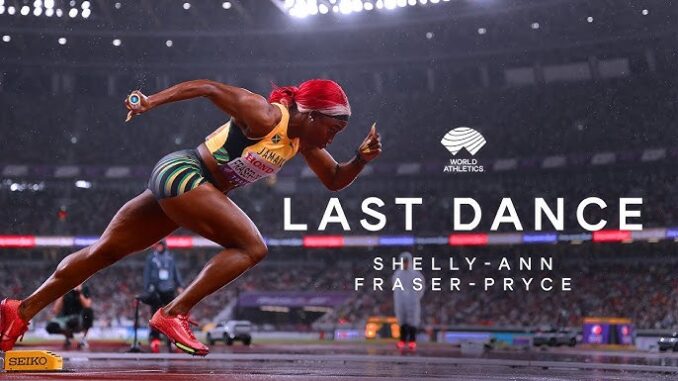
The message behind “The Last Dance – Shelly-Ann Fraser-Pryce” is not just about the final race of a legendary sprinter, but the culmination of an extraordinary career filled with resilience, excellence and legacy. At 38 years of age, Jamaican sprinting icon Shelly-Ann Fraser-Pryce entered the 2025 season with clear intent: this would be the last global championship in her storied career.
From her early days growing up in humble circumstances in Jamaica, to rising through the ranks to become one of the greatest female sprinters in history, Fraser-Pryce’s journey has been defined by perseverance and determination. The “last dance” is therefore symbolic — not only for the end of competing at the highest level, but for the closing of a chapter that has inspired countless athletes, especially women and mothers who aspire to compete at elite levels.
In Tokyo for the 2025 2025 World Athletics Championships, she made the 100 m final for one more time. Though she finished sixth, her presence there mattered more than the placing. She described the moment simply: “I felt the love, I felt the support… To have that reception was truly wonderful.” The message is clear: even when you’ve reached the top, showing up one last time with heart and humility makes all the difference.
Beyond the track times and medals, what makes this “dance” meaningful is what Fraser-Pryce stands for. Known affectionately as the “Pocket Rocket” early in her career for her compact stature and explosive speed, she later also became the “Mommy Rocket” after the birth of her son Zyon in 2017 — and still returned to top-level sprinting. In a sports culture that often sidelines women who become mothers, her story sends a powerful message: motherhood and world-class athletics need not be mutually exclusive.
A video caption reads “Time will honour your greatness” and “Unfinished business” — symbolic of how she approached her final campaign: not as a farewell tour, but as a final act of giving everything. She did not shy away from the idea that her competitive fire remains — it simply has a new home beyond the track.
Equally important is the passing of the baton to the next generation. Fraser-Pryce acknowledged the rising Jamaican sprinters, like the young Tina Clayton, and took pride in the fact that her legacy could help fuel the ambitions of those who follow. The last race becomes a celebration of not just what has been, but what will be.
So what does “The Last Dance” teach us? First: longevity matters. To compete at the highest level for nearly two decades in sprinting — a discipline defined by fractions of a second and razor-thin margins — is extraordinary. Second: when you step up for your final performance, it’s not just about the result, but the meaning behind it. Fraser-Pryce didn’t need to win to make it remarkable; she simply needed to show up, be present, and honour the stage. Third: legacy is as much about what you leave behind as what you achieved. By ending on her own terms, with gratitude and reflection, she sets an example for how to bow out with dignity and purpose.
In a sport driven by youth and speed, her final dance reminds us that heart, experience, and resilience have their place too. The final curve, the stretch to the line, the roar of the crowd — they’re all part of a journey that is greater than one race. When the lights dim on her last global final, the legacy of Shelly-Ann Fraser-Pryce will continue to shine, motivating young athletes across the world that greatness is not just about how fast you run — it’s about how you run your race and how you finish it.
Be the first to comment